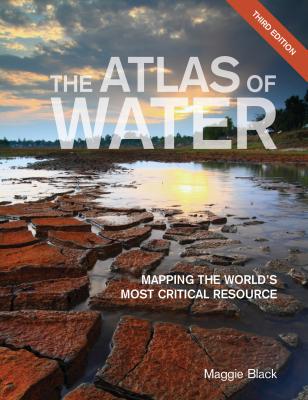ТОП просматриваемых книг сайта:
The Atlas of Water. Maggie Black
Читать онлайн.Название The Atlas of Water
Год выпуска 0
isbn 9780520965607
Автор произведения Maggie Black
Жанр Биология
Издательство Ingram
Global Water
20
Copyright © Myriad Editions
21
Water’s Unequal Distribution
The amount of water that falls as rain, filling lakes, rivers, streams and aquifers, is more than enough to meet our needs, but it is unevenly distributed across the Earth. The floodplains of major rivers have water in abundance, and the need to control and deploy water within them helped prompt the birth of civilizations. In arid zones, tropical and frozen, lack of water constrains human settlement and very different societies have emerged. In temperate areas with steady and reliable rainfall, much of which soaks into the ground, it has been relatively easy to manage freshwater flows so as to secure supplies and prevent floods. In water-short areas, and those where storms wreak havoc, water security is more difficult and societies typically poorer. There is also pressure on freshwater resources from population growth, urbanization, and increasingly industrialized lifestyles. In some desert settings, a traditionally well-adapted way of life has given way to water-profligacy – swimming pools, intensive irrigation – beyond the capacity of local renewable resources. In some parts of the world, notably in Asia, the whole year’s rainfall comes in a brief torrential season, complicating agricultural practice. The storage of water and its channelling via hydraulic infrastructure helps redress this problem. But there is a price to be paid by downstream populations, whose fishing or farming economies are jeopardized by major alterations in water pathways and flows.
Brazil
The Amazon region receives nearly 75% of Brazil’s water, but is very lightly populated. The northeast coastal region, where 20% of people live, receives only 2%.
Both China and India face extreme disparities between their share of the world’s water and of its population, prompting China to propose ambitious projects to shift water between major rivers.
North America
All types of aridity zones are to be found in North America, and for millennia its indigenous peoples lived sustainably off the land. As European settlers moved across the country from east to west they also developed technologies that enabled them to survive in some of the harshest environments, but their use of the available water is not always sustainable in the long-term. Las Vegas, sprawling across the Nevada Desert, relies on the waters of the steadily shrinking Lake Mead.
22
Ecological degradation
The use of hydraulic engineering to redress the unequal distribution of water is, in many areas of the world, pushed to its ecological limits. The heavy use of irrigation in arid areas can lead to salts leaching to the surface, rendering the soil infertile, as here in Iraq.
Australia
Although Australia appears adequately supplied with water on a per capita basis, most of its inland area is desert, soils are thin and fragile, and the country drought-prone. Industrialized farming practices, including irrigation, have undermined long-term land productivity. Water shortage is becoming acute in certain cities, notably Perth.
Africa
The African continent demonstrates contrasting hydrological conditions: desert and semi-desert dominate the north, while countries through which great rivers flow are water-rich. One-third of Africa’s population – 300 million people – live under conditions of water scarcity but geography and costs limit the prospects for major hydraulic infrastructure.
Copyright © Myriad Editions
3 Water Shortage; 4 Rising Demand; 5 Dwindling Supply; 11 River Basin Stresses R
23
Water Shortage
The spectre of water shortage is less a global phenomenon than one threatening particular regions and localities. In areas under-endowed with rainfall or rivers, a combination of ever-increasing demand and, in some cases, less reliable rainfall, exacerbates the prospect of water shortage. Water use grew at more than twice the rate of population increase in the last century. On current trends, by 2030 global freshwater withdrawals will exceed prospective reliable supplies by 40 per cent, with the disparity in some places being more than 50 per cent. At the same time, in some settings, water infrastructure and river diversion to fill reservoirs, irrigate crops and support industrialized lifestyles have already manipulated natural watercourses to the limits of possibility. An increasing number of important rivers – including the Colorado (USA and Mexico), the Indus (India and Pakistan), the Huang He (China), the Rio Grande (North America and Mexico), and the Murray (Australia) – run dry, or almost do so, before they reach the sea for large parts of the year. Groundwater is also being pumped at rates that deplete aquifers and normal underground recharge into rivers and lakes. Erratic weather patterns associated with climate change, in the form of multi-year droughts or altered monsoon behaviours, are also increasing the prospects of water shortage in vulnerable areas.
Q 2 Water’s Unequal Distribution
24
Water stress in countries supplied from Himalayan sources
Population growth, economic expansion and rising living standards are exerting ever more pressure on supplies. In India, freshwater availability per capita has declined from over 4,000 cubic metres to 1,500 cubic metres in less than 50 years. In major river basins shared by Afghanistan, China, India and Pakistan there is strong competition between farmers, industrialists, and urban consumers and the potential for conflict. The depletion of water resources, when combined with annual and seasonal rainfall variability and vulnerability to drought and/or flood, creates severe water stress.
Copyright © Myriad Editions
4 Rising Demand; 5 Dwindling Supply; 6 Competition and Conflict R
25

